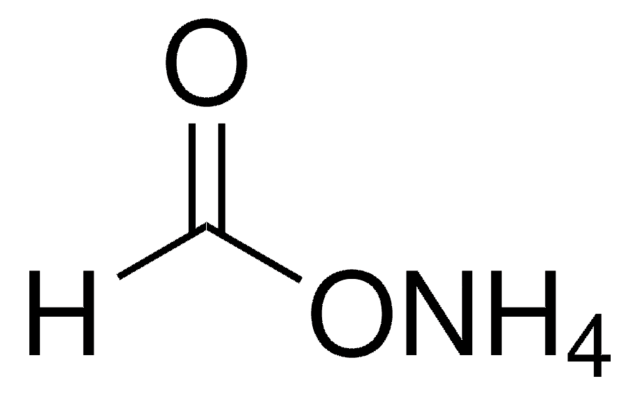679186
Acetonitrile solution
suitable for HPLC, contains 5 % (v/v) water, 0.1 % (v/v) formic acid, 0.05 % (w/v) ammonium formate
Synonym(s):
ACN, Cyanomethane, Ethyl nitrile, Methyl cyanide
About This Item
Recommended Products
Product Name
Acetonitrile solution, contains 0.05 % (w/v) ammonium formate, 5 % (v/v) water, 0.1 % (v/v) formic acid, suitable for HPLC
grade
HPLC grade
Quality Level
vapor density
1.41 (vs air)
vapor pressure
72.8 mmHg
form
liquid
contains
0.05 % (w/v) ammonium formate
0.1 % (v/v) formic acid
5 % (v/v) water
expl. lim.
8 % (lit.)
technique(s)
HPLC: suitable
bp
81-82 °C (lit.)
mp
-48 °C (lit.)
density
0.782 g/mL at 25 °C
0.807 g/mL at 25 °C
format
mixture
SMILES string
CC#N
InChI
1S/C2H3N/c1-2-3/h1H3
InChI key
WEVYAHXRMPXWCK-UHFFFAOYSA-N
Looking for similar products? Visit Product Comparison Guide
General description
Application
- Detection of Amino Acids via Chemiluminescence: Acetonitrile is employed in the detection of α-amino acids using peroxyoxalate chemiluminescence. A study demonstrated the use of a mixed solution of water, acetonitrile, and ethyl acetate for detecting amino acids, highlighting its efficacy in analytical applications. This method enhances the sensitivity and accuracy of amino acid detection, making it crucial for biochemical and clinical analyses (Kan et al., American Journal of Analytical Chemistry, 2020).
- Redox Properties of N-Hydroxyimides: Acetonitrile mixed with sulfuric acid is used to study the redox properties of N-hydroxyimides, acting as a hydrogen atom transfer (HAT) mediator for alcohol oxidation. This application is significant in understanding the electrochemical behavior of organic compounds and developing new catalytic processes for oxidation reactions (Kishioka, Journal of Electroanalytical Chemistry, 2023).
- Electrode Reactions in Catalytic Mediation: Acetonitrile solution is used in investigating the electrode reactions of N-hydroxyphthalimide in sulfuric acid. This study focuses on its role as a catalytic mediator for alcohol oxidation, providing insights into the electrochemical mechanisms involved. The findings contribute to the development of efficient catalytic systems for organic transformations (Kishioka, Journal of Electroanalytical Chemistry, 2022).
- Excitation of Europium Complexes: Acetonitrile solution is utilized in the interaction of Eu(FOD)3 with xenon difluoride to study ligand-assisted excitation of Eu(III). This research explores the photophysical properties of europium complexes, which are essential for developing luminescent materials for various applications, including lighting and display technologies (Masyagutova et al., Journal of Fluorine Chemistry, 2024).
Packaging
As a global leader in lab reagents, we are constantly looking for new ways to optimize the safety of our products. The newly developed 4L solvent bottle design features advanced sealing technology that eliminates leaks to make the handling of solvents safer and more convenient than ever before.
See all the new features here!
Preparation Note
Signal Word
Danger
Hazard Statements
Precautionary Statements
Hazard Classifications
Acute Tox. 4 Dermal - Acute Tox. 4 Inhalation - Acute Tox. 4 Oral - Eye Irrit. 2 - Flam. Liq. 2
Storage Class Code
3 - Flammable liquids
WGK
WGK 2
Flash Point(F)
36.0 °F - closed cup
Flash Point(C)
2.22 °C - closed cup
Personal Protective Equipment
Choose from one of the most recent versions:
Already Own This Product?
Find documentation for the products that you have recently purchased in the Document Library.
Our team of scientists has experience in all areas of research including Life Science, Material Science, Chemical Synthesis, Chromatography, Analytical and many others.
Contact Technical Service




